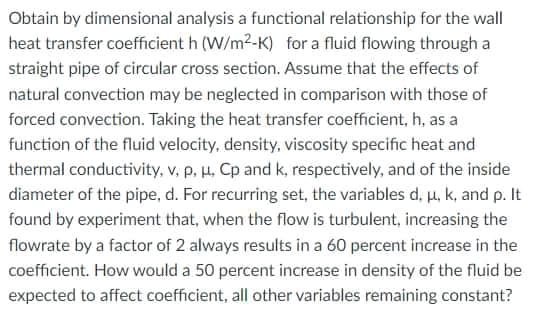Obtain by dimensional analysis a functional relationship for the wall heat transfer coefficient h (W/m2-K) for a fluid flowing through a straight pipe of circular cross section. Assume that the effects of natural convection may be neglected in comparison with those of forced convection. Taking the heat transfer coefficient, h, as a function of the fluid velocity, density, viscosity specific heat and thermal conductivity, v, p, µ, Cp and k, respectively, and of the inside diameter of the pipe, d. For recurring set, the variables d, u, k, and p. It found by experiment that, when the flow is turbulent, increasing the flowrate by a factor of 2 always results in a 60 percent increase in the coefficient. How would a 50 percent increase in density of the fluid be expected to affect coefficient, all other variables remaining constant?
Obtain by dimensional analysis a functional relationship for the wall heat transfer coefficient h (W/m2-K) for a fluid flowing through a straight pipe of circular cross section. Assume that the effects of natural convection may be neglected in comparison with those of forced convection. Taking the heat transfer coefficient, h, as a function of the fluid velocity, density, viscosity specific heat and thermal conductivity, v, p, µ, Cp and k, respectively, and of the inside diameter of the pipe, d. For recurring set, the variables d, u, k, and p. It found by experiment that, when the flow is turbulent, increasing the flowrate by a factor of 2 always results in a 60 percent increase in the coefficient. How would a 50 percent increase in density of the fluid be expected to affect coefficient, all other variables remaining constant?
Principles of Heat Transfer (Activate Learning with these NEW titles from Engineering!)
8th Edition
ISBN:9781305387102
Author:Kreith, Frank; Manglik, Raj M.
Publisher:Kreith, Frank; Manglik, Raj M.
Chapter5: Analysis Of Convection Heat Transfer
Section: Chapter Questions
Problem 5.54P
Related questions
Question

Transcribed Image Text:Obtain by dimensional analysis a functional relationship for the wall
heat transfer coefficient h (W/m2-K) for a fluid flowing through a
straight pipe of circular cross section. Assume that the effects of
natural convection may be neglected in comparison with those of
forced convection. Taking the heat transfer coefficient, h, as a
function of the fluid velocity, density, viscosity specific heat and
thermal conductivity, v, p, H, Cp and k, respectively, and of the inside
diameter of the pipe, d. For recurring set, the variables d, u, k, and p. It
found by experiment that, when the flow is turbulent, increasing the
flowrate by a factor of 2 always results in a 60 percent increase in the
coefficient. How would a 50 percent increase in density of the fluid be
expected to affect coefficient, all other variables remaining constant?
Expert Solution
This question has been solved!
Explore an expertly crafted, step-by-step solution for a thorough understanding of key concepts.
This is a popular solution!
Trending now
This is a popular solution!
Step by step
Solved in 4 steps with 4 images

Knowledge Booster
Learn more about
Need a deep-dive on the concept behind this application? Look no further. Learn more about this topic, mechanical-engineering and related others by exploring similar questions and additional content below.Recommended textbooks for you

Principles of Heat Transfer (Activate Learning wi…
Mechanical Engineering
ISBN:
9781305387102
Author:
Kreith, Frank; Manglik, Raj M.
Publisher:
Cengage Learning

Principles of Heat Transfer (Activate Learning wi…
Mechanical Engineering
ISBN:
9781305387102
Author:
Kreith, Frank; Manglik, Raj M.
Publisher:
Cengage Learning